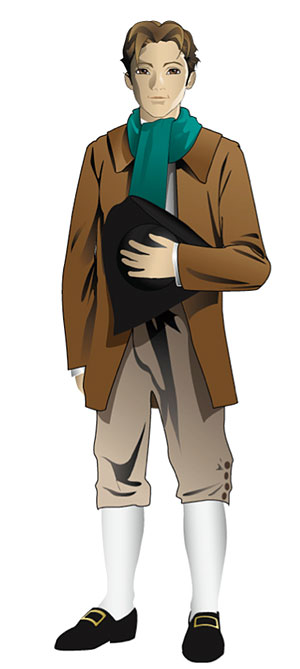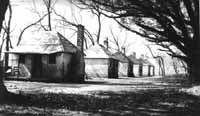October 2010
Mission US Goes Live!
 We are pleased to announce the public launch of a groundbreaking multimedia initiative: Mission US, a free online history game designed to improve middle school students’ understanding of US history and their critical-thinking skills through innovative, engaging play. The first game, “For Crown or Colony?,” is now live. In the game, students assume the role of Nathaniel Wheeler, a young printer’s apprentice, and through encounter, inquiry, and decision-making learn about the critical events of 1770 leading up to the Boston Massacre. Three additional games focusing on significant eras and events in U.S. history will follow in the next two years.
We are pleased to announce the public launch of a groundbreaking multimedia initiative: Mission US, a free online history game designed to improve middle school students’ understanding of US history and their critical-thinking skills through innovative, engaging play. The first game, “For Crown or Colony?,” is now live. In the game, students assume the role of Nathaniel Wheeler, a young printer’s apprentice, and through encounter, inquiry, and decision-making learn about the critical events of 1770 leading up to the Boston Massacre. Three additional games focusing on significant eras and events in U.S. history will follow in the next two years.
ASHP/CML is working on Mission US in partnership with New York public television station Thirteen/WNET; Electric Funstuff, a commercial gaming company focusing on education; and the Education Development Center’s Center for Children and Technology. The Corporation for Public Broadcasting provided major funding for the project.
Two New Teaching American History Programs at ASHP/CML
In August, we received word that two New York City Department of Education professional development programs involving ASHP/CML received funding through the U. S. Department of Education’s Teaching American History grant competition. In one of these programs, we will work with 7th and 8th grade social studies teachers in three Brooklyn and Queens districts. This program will combine compelling social history content with document-based classroom approaches designed to support the learning of these teachers’ special needs and English Language Learner (ELL) students. In our second new TAH program we will be working with teachers at small high schools in the Bronx, guiding teachers as they use social history sources to develop new classroom materials for their students.
Civil War Sesquicentennial Public Program: Still Hazy After All These Years

Did the Real War Ever Get in the Books? New Scholarship on the Civil War
Thursday, February 3, 2011, at 6:00 pm
Panelists: Gregory Downs, City College of New York, CUNY; Bruce Levine, University of Illinois at Urbana-Champaign; Stephanie McCurry, University of Pennsylvania; James Oakes, The Graduate Center, CUNY
The Great Divide? Civil War Myths and Misinformation
Tuesday, April 5, 2011, at 6:00 pm
Panelists: Jim Cullen, The Ethical Culture Fieldston School; Stan Deaton, Georgia Historical Society; Gary W. Gallagher, University of Virginia; Scott Nelson, College of William and Mary
Is There Anything More to See? Civil War Photography and History
Wednesday, November 3, 2011, at 6:00 pm
Panelists: Anthony Lee, Mount Holyoke College; Mary Niall Mitchell, University of New Orleans; Martha A. Sandweiss, Princeton University; Deborah Willis, Tisch School of the Arts, New York University
All sessions are free of charge and will be held in the Martin Segal Theatre at the Graduate Center (34th Street and Fifth Avenue in midtown Manhattan). More on the series.
HERB: Social History for Every Classroom
ASHP/CML is continuing work in earnest on our online teacher resource database, which will be known as HERB (in honor of the late historian and our co-founder Herbert Gutman). We’ve entered more than 1,000 social history documents, teaching activities, images, and other resources, and currently are finalizing design and building a beta version with the aim of a full public launch in January 2011.
HERB is being built with Omeka, an open source curation and document management application created by George Mason University’s Center for History and New Media. We’re attempting to incorporate as much of the feedback we received from teachers and historians who responded to a survey and will test a demo beta version later this fall. Check the ASHP/CML homepage and our Now and Then blog for updates on HERB’s progress!
Featured Document: Mary Reynolds
 Though rare, slave cabins still dot the landscape of the southern United States. Some are parts of plantation museums, though former quarters are seldom interpreted with the same zeal as the main house. Almost invariably, former slave quarters stand empty today, making it hard to picture the complex and vibrant communities that once occupied them. This month’s featured document is an oral history of Mary Reynolds, who recalls her girlhood growing up on cotton and sugar plantations in Louisiana. Though 105 years old when she narrated her story to a W.P.A. interviewer, Reynolds’ descriptions are vivid (and her contempt for her former master is still sharp). Reynolds’ oral history is one source for understanding the complicated power negotiations between masters and slaves, as slaves raised families, created stories, crafts and music, and sought a measure of autonomy in places designed by and owned by slaveholders. Read Mary Reynolds’ oral history and learn more about the geography of the plantation.
Though rare, slave cabins still dot the landscape of the southern United States. Some are parts of plantation museums, though former quarters are seldom interpreted with the same zeal as the main house. Almost invariably, former slave quarters stand empty today, making it hard to picture the complex and vibrant communities that once occupied them. This month’s featured document is an oral history of Mary Reynolds, who recalls her girlhood growing up on cotton and sugar plantations in Louisiana. Though 105 years old when she narrated her story to a W.P.A. interviewer, Reynolds’ descriptions are vivid (and her contempt for her former master is still sharp). Reynolds’ oral history is one source for understanding the complicated power negotiations between masters and slaves, as slaves raised families, created stories, crafts and music, and sought a measure of autonomy in places designed by and owned by slaveholders. Read Mary Reynolds’ oral history and learn more about the geography of the plantation.
Don’t forget to visit Now and Then: An ASHP blog for updates on ASHP/CML events and other staff musings.
